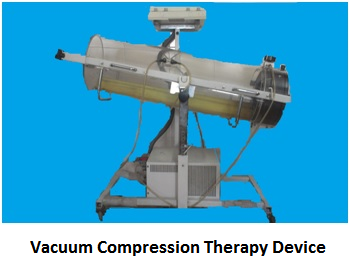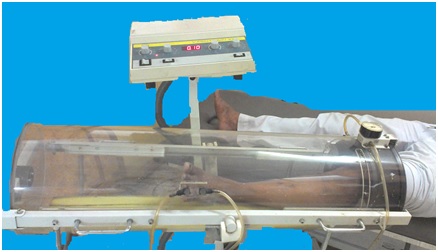In 1956, Erler and Itting designed a vacuum-compression unit that served as the prototype for the clinical model in use today. The device consists of a plexiglass chamber connected to a compressor. The unit provides a timed alteration of positive and negative pressures at a selectable range of intensities. Researchers believe that VCT systems do improve total tissue blood flow and oxygenation.
[1]In the year 1995, a commercial system for promoting vacuum assisted closure (VAC) also known as vacuum therapy, vacuum sealing or topical negative pressure therapy, was introduced into the United States market. This equipment, called the VAC, was designed to overcome some of the problems associated with conventional methods for the creation of negative pressure
The device comprises of
- Vacuum chamber
- Pressure Monitor
- Rubber cuff
- Compressor Unit.
The cycles of positive and negative pressure aids in improving circulation. The volume of an elastic vessel can be increased by the application of a vacuum force on its outer wall
[2] In the negative pressure phase of VCT , just such a force is exerted on the extremities and its vessels.In the positive pressure phase, the venous drainage is facilitated.Thus the alteration of positive and negative pressure facilitates increased arterial and capillary circulation and better venous drainage.
The individuals’s extremity will be placed inside the plexiglass chamber of the vacuum compression device up to mid thigh without clothing. The rubber cuff of appropriate size for the individual was selected based of mid thigh/mid arm circumference to ensure snug fit. The parameters to be set at negative pressure of – 0.10 bar (-75 mmHg) for 60 seconds and positive pressure of 0.05 bar (38.5 mmHg) for 30 seconds as suggested by Akbari et al (2007)
[1] (For diabetic ulcer healing)
Literature evidences suggest the therapy for one hour on alterative days for ten sessions .
The individuals should be instructed that they will feel sense of pull during negative pressure phase and sense of push during positive pressure phase. Any uncomfortable sensations should be repored immediately.
There may be few temporary side effects like tingling and numbness may occur.
- ↑ 1.0 1.1 Akbari et al ; Effects of vacuum compression therapy on healing of diabetic foot ulcers :Randomized control trial ;JRRD; Vol 44; No 5;2007; 631-636.
- ↑ Nave CR, Nave BC, eds. Physcs for the Health Sciences. Philadelphia, Pa: WB Saunders CO; 1975:73-75.
.








